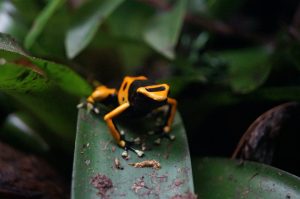The Poison Dart Frog, they maybe cute and colourful but they deserve your respect. They’re some of the most toxic animals in the world.

In this post, we’re showcasing the Poison Dart Frog in all its weirdness and beauty. Filling you in on everything from what they eat to just how toxic they really are.
Quick Links
- What Are Poison Dart Frogs?
- Where Are Poison Dart Frogs Found?
- What Do Poison Dart Frogs Eat?
- How Toxic Are Poison Dart Frogs?
- Are Poison Dart Frogs Endangered?
What Are Poison Dart Frogs?
Poison dart frogs are a group of amphibians. Characterised by their colourful bodies and toxicity. Though not all the 170 species in the family are poisonous. Most are very small in size, with the largest, the golden dart frog, being just 5.5 centimetres.
Unlike many other amphibians, poison dart frogs are diurnal, meaning they’re most active in the daytime – just like us humans. This is quite rare for frogs, as most species are nocturnal.
Poison dart frogs are among the most poisonous amphibians in the world. However, they don’t use this as a means of attack. Instead, it acts as a deterrent, with their brightly-coloured bodies essentially telling would-be predators “I’m poisonous, don’t eat me.”
This means poison dart frogs fall into the category of aposematic animals. Meaning they have a certain characteristic which deters potential predators. There are other aposematic animals including skunks, with their formidable scent glands. The cuttlefish, whose incredible colour-changing skin warns passing hunters that it’s among the most poisonous creatures in the ocean.
Unlike many other creatures of the rainforest, who rely on camouflage for both defence and hunting. The Poison Dart Frog is highly visible, letting predators know to avoid it. They come in a staggering variety of bright colours and patterns. Making sure they stand out against the green canopy of their forest home.
Where Are They Found?
Poison dart frogs live in the tropical rainforests of Central and South America. The humid climate means they can live away from permanent bodies of water. They tend to remain close to the forest floor. However, they sometimes climb trees up to a height of around 10 metres.
While the rainforest is their preferred habitat, poison dart frogs live in many types of tropical environments. This includes marshes, shrubland, swamps, savanna grasslands, and farmland. Sightings have increased outside forested areas. This is most likely due to their habitat suffering at the hands of deforestation.
Despite severe habitat destruction, poison dart frogs remain endemic to the tropical and subtropical regions of Central and South America. Found in Bolivia, Costa Rica, Brazil, Colombia, Ecuador, Venezuela, Suriname, French Guiana, Panama, Guyana and Nicaragua. Also, Hawaii has recently had them introduced.
What Do They Eat?
Poison dart frogs are carnivores, surviving on a diet of small insects. Things like fruit flies, termites, ants, young crickets, and some smaller species of beetles. They’re excellent opportunistic hunters, relying on their long, sticky tongues to flash out and catch fast-moving prey in the blink of an eye.
An interesting theory some scientists have is that poison dart frogs became toxic because of their diet. Given that many insects in the rainforest are poisonous. That eating these poisonous insects, through a long period of evolution, the frogs became toxic.
This has proven to be the case since poison dart frogs have been brought into captivity. Captive animals lose their toxicity due to a different diet of non-poisonous insects.
How Toxic Are Poison Dart Frogs?
Not all poison dart frogs are poisonous, but those that are poisonous tend to be highly toxic. The frogs carry poison on their skin as a means of deterring predators, so they aren’t safe to handle.
To put this toxicity into perspective, the most poisonous of the lot is the Golden Poison Frog. Thought to have enough toxin in its skin to kill 20,000 mice or 20 fully-grown people. So, as you can tell, these guys aren’t messing around!
Another interesting thing to note about poison dart frogs is where they got their name. It comes from the practice of Native American tribesmen using the toxic secretions of the frogs to tip blow darts. Commonly used for hunting. This gives you an idea of the potency of their toxins, and the respect we humans have for them.
Are They An Endangered Species?
Sadly, many poison dart frogs now appear on the endangered species list. As deforestation and human infrastructure projects continue to encroach on their natural habitat.
Over the past three decades, poison dart frogs have slipped further down the IUCN’s conservation chart. Deforestation continues to devastate precious habitats like the Amazon rainforest. The rapid human population growth in the countries where these frogs live has also exacerbated the problem. Towns and cities begin sprawling onto lands where these animals typically seek refuge from deforestation.
Habitat loss isn’t the only thing which threatens poison dart frog numbers. Chytridiomycosis, a bacterial disease found in amphibians, kills thousands of animals each year. Scientists believe it could have resulted in the extinction of some species.
While the origins of chytridiomycosis are unclear, studies suggest that climate change could be accelerating the disease’s spread. Rising temperatures make it easier for bacteria to incubate in tropical environments. Putting species like poison dart frogs right in the firing line.
Experience Poison Dart Frogs at Blue Planet Aquarium
With their amazing displays of colour, poison dart frogs put on quite the show for such small animals. That’s why a visit to the Frog Zone at Blue Planet Aquarium is a must for a close (but not too close!) encounter with these wonderful creatures.
For a fun and educational way to see some of the world’s most beautiful amphibians and marine animals, start planning your trip to Blue Planet Aquarium today. For more information and tickets, visit the homepage.
